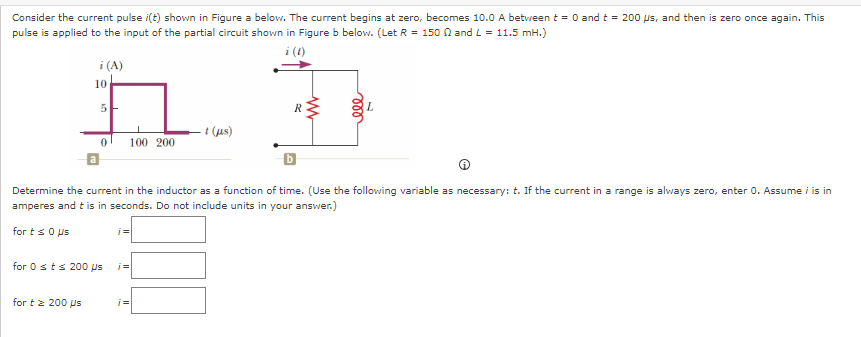Consider the current pulse i(t) shown in Figure a below. The current begins at zero, becomes 10.0 A between t = 0 and t = 200 µs, and then is zero once again. This pulse is applied to the input of the partial circuit shown in Figure b below. (Let R = 150 02 and L = 11.5 mH.) i (A) 10 고 5 0 100 200 for 0 st = 200 us -t (μs) for tz 200 us R ww Determine the current in the inductor as a function of time. (Use the following variable as necessary: t. If the current in a range is always zero, enter 0. Assume i is in amperes and it is in seconds. Do not include units in your answer.) for t ≤ 0 us ele
Consider the current pulse i(t) shown in Figure a below. The current begins at zero, becomes 10.0 A between t = 0 and t = 200 µs, and then is zero once again. This pulse is applied to the input of the partial circuit shown in Figure b below. (Let R = 150 02 and L = 11.5 mH.) i (A) 10 고 5 0 100 200 for 0 st = 200 us -t (μs) for tz 200 us R ww Determine the current in the inductor as a function of time. (Use the following variable as necessary: t. If the current in a range is always zero, enter 0. Assume i is in amperes and it is in seconds. Do not include units in your answer.) for t ≤ 0 us ele
Chapter14: Inductance
Section: Chapter Questions
Problem 55P: How long after switch S1 is thrown does it take the current in the circuit shown to reach half its...
Related questions
Question

Transcribed Image Text:Consider the current pulse i(t) shown in Figure a below. The current begins at zero, becomes 10.0 A between t = 0 and t = 200 µs, and then is zero once again. This
pulse is applied to the input of the partial circuit shown in Figure b below. (Let R = 150 02 and L = 11.5 mH.)
i (A)
10
for t > 200 us
5
0 100 200
Determine the current in the inductor as a function of time. (Use the following variable as necessary: t. If the current in a range is always zero, enter 0. Assume i is in
amperes and it is in seconds. Do not include units in your answer.)
for t ≤ 0 us
for 0 st≤ 200 μs
i=
- t (μs)
i=
Expert Solution
This question has been solved!
Explore an expertly crafted, step-by-step solution for a thorough understanding of key concepts.
This is a popular solution!
Trending now
This is a popular solution!
Step by step
Solved in 3 steps

Knowledge Booster
Learn more about
Need a deep-dive on the concept behind this application? Look no further. Learn more about this topic, physics and related others by exploring similar questions and additional content below.Recommended textbooks for you

